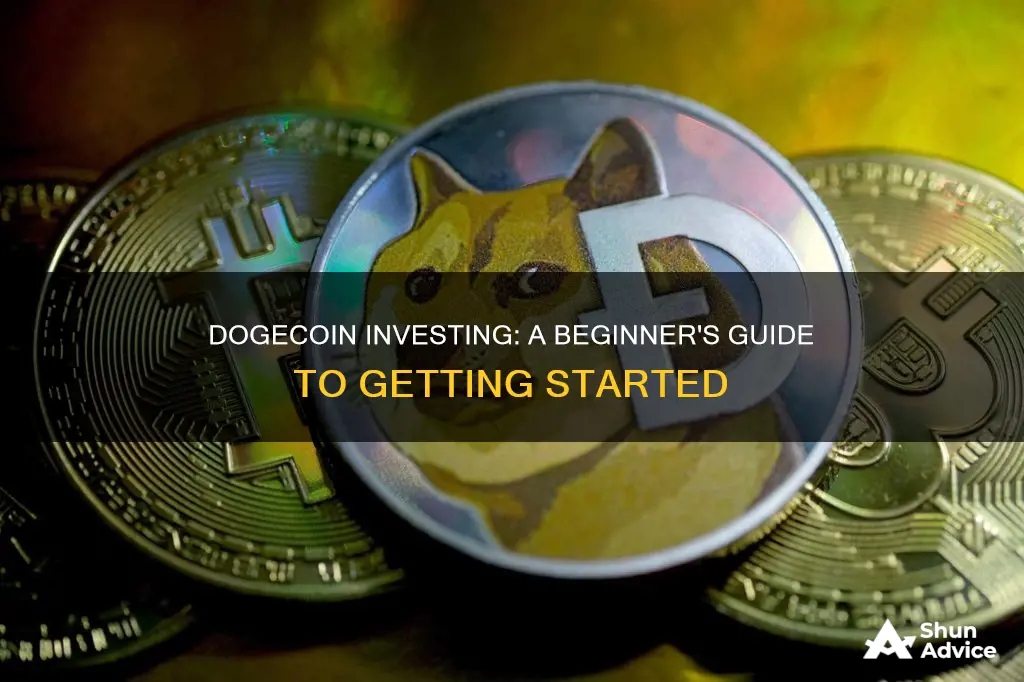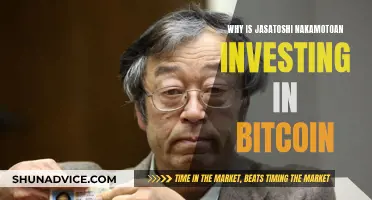
Dogecoin is a cryptocurrency that was created as a joke in 2013, inspired by the Doge meme featuring a Shiba Inu dog. Despite its humorous origins, Dogecoin has grown into a recognised digital currency with a strong community. In this paragraph, we will explore the basics of Dogecoin investing, including its history, key characteristics, and the potential risks and rewards for investors. We will also discuss how Dogecoin's unique position in the cryptocurrency ecosystem has contributed to its popularity and how it differs from other cryptocurrencies like Bitcoin.
| Characteristics | Values |
|---|---|
| Type of Cryptocurrency | Meme coin |
| Founders | Billy Markus and Jackson Palmer |
| Year of Launch | 2013 |
| Consensus Mechanism | Proof-of-work (PoW) |
| Security | Auxiliary Proof of Work (AuxPoW) |
| Programming Language | C++ |
| Block Time | 1 minute |
| Supply Limit | No |
| Use Cases | Small transactions, online tipping, charitable donations, crowdfunding |
| Coin Price | $0.165 (as of May 2023) |
| Celebrity Endorsements | Elon Musk, Snoop Dogg, Mark Cuban |
What You'll Learn

Dogecoin's value and volatility
Dogecoin is a highly volatile asset. Its value is influenced by several factors, including celebrity endorsements, social media hype, and the actions of its die-hard community of fans.
One of the key factors affecting Dogecoin's value is its unlimited supply. Unlike Bitcoin and many other cryptocurrencies, Dogecoin does not have a fixed supply. This means that its price is not supported by scarcity, and relies on buyers constantly purchasing new Dogecoins to maintain its value. The lack of a fixed supply also means that Dogecoin is subject to high inflation, which can further impact its value.
Dogecoin's value is also influenced by its block reward schedule. Initially, Dogecoin used a random block reward schedule, where miners could receive anything from 0 to 1 million Dogecoins for mining a single block. This was later changed to a fixed schedule, where successful miners receive 10,000 Dogecoins per block. Dogecoin's mining difficulty adjustment, which controls how easy it is to mine a block, is tweaked every block, making it easier to mine Dogecoin compared to other cryptocurrencies.
The high issuance rate of Dogecoin also impacts its value. Dogecoin has a fixed block reward, with 10,000 Dogecoins being generated every minute. In comparison, Bitcoin generates 6.25 Bitcoin every 10 minutes. This means that more Dogecoin enters circulation in two days than the total supply of Bitcoin, which is set to top out at 21 million around the year 2140.
Dogecoin's value has experienced significant fluctuations since its launch. It initially soared by 1,061% in 15 days after its release in 2013, reaching a price of $0.0023. However, it then experienced a prolonged period of low trading activity, with its value falling below $0.001. Dogecoin's value surged again in 2021, driven by endorsements from celebrities like Elon Musk and a renewed interest from the Reddit community. It posted a 9,884% gain between January and May 2021, reaching an all-time high of $0.74.
Despite its volatile nature, Dogecoin has exhibited lower volatility than Bitcoin in recent times. In September 2023, Dogecoin had a lower annualized 30-day realized volatility of 30% compared to Bitcoin's 35%. This shift may be due to a lack of investor interest in alternative cryptocurrencies, as Bitcoin's dominance rate in the crypto market has surged to 50%.
Overall, Dogecoin's value is highly volatile and susceptible to various factors, including celebrity endorsements, community interest, and its unique technical characteristics, such as its unlimited supply and high issuance rate.
The Best Cryptocurrency Coins to Invest in Now
You may want to see also

Dogecoin's security and scalability
To further enhance security, Dogecoin adopted Auxiliary Proof of Work (AuxPoW) in 2014, allowing it to be merge-mined with Litecoin. This means that miners can simultaneously mine both Litecoin and Dogecoin without additional energy consumption, increasing the hashing power securing the Dogecoin network and making it more resilient against attacks. Dogecoin's codebase, inherited from Bitcoin, is primarily written in C++, providing a robust and efficient backbone for secure transactions.
Regarding scalability, Dogecoin's block time is set at 1 minute, enabling faster transaction processing compared to many legacy networks. This feature makes Dogecoin attractive for microtransactions and online tipping, fostering a vibrant community that uses it for tipping content creators, charitable donations, and crowdfunding initiatives. However, the faster block time also contributes to rapid blockchain growth, presenting potential challenges for node operators in terms of storage requirements.
The scalability of Dogecoin, like other PoW cryptocurrencies, is a subject of discussion. While it enables quicker transactions, it also raises concerns about the increasing blockchain size and its impact on storage capacity. Additionally, the environmental impact of PoW mining activities, including those associated with Dogecoin, has sparked discussions about more energy-efficient consensus mechanisms.
The Dogecoin development team and community are actively exploring ways to improve the network's efficiency, security, and scalability. Proposals for adopting layer-2 solutions, enhancing the protocol, and reducing the environmental impact of mining are part of ongoing discussions. The unique position of Dogecoin as both a functional, transactional currency and a community-driven project highlights its potential for further innovation and adaptation in the cryptocurrency ecosystem.
Smartly Diversifying Your Crypto Portfolio: How Many Coins?
You may want to see also

Dogecoin's transaction processing and capabilities
Dogecoin's block time is set at 1 minute, which is much faster when compared to many legacy networks. This enables Dogecoin to process transactions more quickly, making it a popular choice for small-scale transfers, microtransactions, and online tipping. The network's design to handle a larger volume of transactions with minimal fees has made Dogecoin attractive for these smaller transactions.
Dogecoin's low transaction fees and quick confirmation times have fostered a vibrant community that uses Dogecoin for tipping content creators, charitable donations, and crowdfunding initiatives. The Dogecoin community is typically known for its friendly and welcoming ethos, often rallying around various causes and projects.
One of Dogecoin's standout capabilities is its suitability for microtransactions. Dogecoin was designed to be a more approachable alternative to Bitcoin, reaching users put off by the cold complexity of Bitcoin and other cryptocurrencies considered more sophisticated. Dogecoin's strong and vibrant community is its main asset, and its unique value proposition.
Dogecoin's inflationary design means there is no maximum limit to the number of coins in circulation. This was a conscious decision to ensure that miners would always be rewarded with new Dogecoin, so there would always be an incentive to mine more coins. This decision also helps to keep transaction fees low.
Dogecoin Investing: A Guide for Indians
You may want to see also

Dogecoin's community and culture
Dogecoin is a cryptocurrency with a fun and friendly brand image that aims to be a supportive introduction to cryptocurrency for the general public. It is considered the first "meme coin" and the first "dog coin". It was created by software engineers Billy Markus and Jackson Palmer, who wanted to create a peer-to-peer digital currency that could reach a broader demographic than Bitcoin. Dogecoin was formed as a joke, making fun of the wild speculation in cryptocurrencies at the time.
Dogecoin quickly developed its own online community, reaching a peak market capitalization of over US$85 billion on May 5, 2021. As of 2021, it is the sleeve sponsor of Watford Football Club. The Dogecoin community and foundation have encouraged fundraising for charities and other notable causes, including a fundraiser for the Jamaican Bobsled Team, which had qualified for, but could not afford to go to, the Sochi Winter Olympics. The Dogecoin community also raised funds for a second Sochi athlete, Shiva Keshavan. In 2014, the Dogecoin Foundation, led by Eric Nakagawa, began collecting donations to build a well in the Tana river basin in Kenya for World Water Day.
Dogecoin has a dedicated blog and forum, and its market value reached $8 million, once jumping to become the seventh-largest electronic currency in the world. Dogecoin's community includes friendly folks who support each other, teach people about cryptocurrency, fundraise, have fun, make memes, and be absurd. This is captured by Dogecoin's unofficial tagline: Do Only Good Everyday.
Dogecoin's blockchain cannot interact with smart contracts directly. However, Dogecoin can be tied to the Ethereum blockchain to access some decentralized finance (DeFi) instruments. Dogecoin's origin as a "joke", which makes it the first meme coin, has made it difficult to be taken seriously by mainstream media and financial experts.
Dogecoin has been described by some commentators as a form of Ponzi scheme. Critics allege that Dogecoin investors who purchased Dogecoins early on have a large financial incentive to draw others into purchasing more Dogecoins to drive the price up, therefore benefitting the early investors financially at the direct expense of later purchasers. This is primarily because Dogecoin does not have a supply cap like other cryptocurrencies such as Bitcoin.
The Ultimate Guide to Investing in Litecoin Cash
You may want to see also

Dogecoin's history and future developments
Dogecoin was created by software engineers Billy Markus and Jackson Palmer, who wanted to satirise the hype surrounding cryptocurrencies at the time. Launched on 6 December 2013, it was introduced as a "fun and friendly internet currency". It is considered the first "meme coin", and its logo is the face of Kabosu from the "doge" meme.
Within two weeks, Dogecoin had established a dedicated blog and forum, and its market value reached $8 million, becoming the seventh-largest electronic currency in the world. Dogecoin's popularity was helped by its active community, which has funded charitable efforts and other projects, including sponsoring a NASCAR. Dogecoin is also used as a tipping service to reward users for their posts.
Dogecoin is inflationary, meaning there is no maximum limit to the number of coins in circulation. This is in contrast to Bitcoin, which has a limited supply of 21 million coins. Dogecoin's inflationary nature is attractive to miners, who will always be rewarded with new Dogecoin, ensuring there is always an incentive to mine more coins.
Dogecoin's popularity has been boosted by celebrity endorsements, most notably by Elon Musk, who has tweeted about the coin and described it as the "cryptocurrency of the people". Other celebrities who have contributed to Dogecoin's popularity include Snoop Dogg and Gene Simmons.
In May 2021, Dogecoin reached a peak market capitalisation of over $85 billion, and in April 2023, a Dogecoin increase was attributed to Elon Musk changing the Twitter app logo to a Doge logo.
As of May 2024, Dogecoin's market capitalisation was nearly $24.39 billion. Despite its popularity, Dogecoin hasn't seen any significant updates since 2015, and its popularity is largely driven by tweets from influencers.
Future Developments
Dogecoin's future prospects are tied to its ability to increase its utility beyond tipping. Its inflationary nature could be a positive or a negative for its long-term prospects, depending on your perspective. Some analysts predict that Dogecoin will remain a major player in the cryptocurrency market for years to come, with its price potentially reaching $4,423 by 2050. However, others argue that its popularity as a meme coin could be a double-edged sword, and that its limitless issuance could challenge its price stability in the long term.
In a recent interview, Elon Musk stated that SpaceX is planning to use Dogecoin for its space mission, which is expected to cause a sudden spike in the price of Dogecoin. Musk has also said that Dogecoin is more eco-friendly than Bitcoin, which could indicate that Tesla will start accepting Dogecoin for its car units in the future.
Dogecoin's management has increased its efforts to eliminate flaws and position Dogecoin as a safe option for businesses that want to use cryptocurrency for their transactions.
Litecoin Cash: A Smart Investment Move?
You may want to see also
Frequently asked questions
Dogecoin is a cryptocurrency that was created as a joke in 2013, inspired by the "Doge" meme featuring a Shiba Inu. It was designed to be a more accessible and less serious alternative to Bitcoin.
Dogecoin uses a proof-of-work (PoW) consensus mechanism, where miners solve complex mathematical problems to validate transactions and secure the network. It is based on Litecoin and was created using the same programming language, C++.
Dogecoin can be purchased on various crypto exchanges, such as Uphold, Paybis, and Kraken. It can also be traded on platforms like Robinhood and eToro.
Dogecoin, like other cryptocurrencies, is a highly volatile and risky investment. Its value is based on speculation and can fluctuate abruptly due to media attention, celebrity endorsements, or community efforts. There is no maximum limit to the number of Dogecoins, and it is not backed by any tangible asset or regulatory authority.
Dogecoin has a strong and vibrant community, which has resulted in a cult following. It is also more approachable and friendly than other cryptocurrencies, making it an attractive entry point for new crypto investors. Dogecoin is also known for its low transaction fees and quick confirmation times, making it suitable for microtransactions and online tipping.







